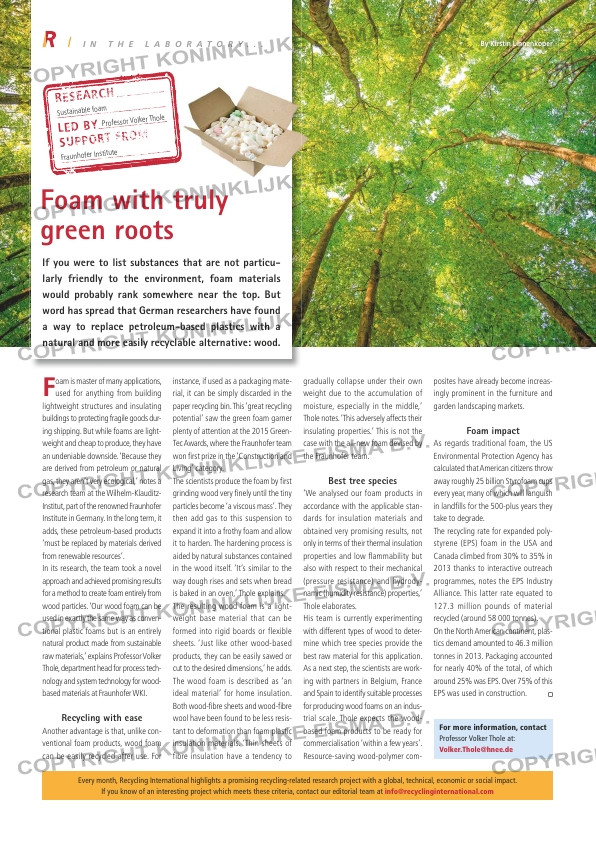Page 31 from: June / July 2015

I N T H E L A B O R A T O R Y . . .
posites have already become increas-
ingly prominent in the furniture and
garden landscaping markets.
Foam impact
As regards traditional foam, the US
Environmental Protection Agency has
calculated that American citizens throw
away roughly 25 billion Styrofoam cups
every year, many of which will languish
in landfi lls for the 500-plus years they
take to degrade.
The recycling rate for expanded poly-
styrene (EPS) foam in the USA and
Canada climbed from 30% to 35% in
2013 thanks to interactive outreach
programmes, notes the EPS Industry
Alliance. This latter rate equated to
127.3 million pounds of material
recycled (around 58 000 tonnes).
On the North American continent, plas-
tics demand amounted to 46.3 million
tonnes in 2013. Packaging accounted
for nearly 40% of the total, of which
around 25% was EPS. Over 75% of this
EPS was used in construction.
Foam is master of many applications, used for anything from building
lightweight structures and insulating
buildings to protecting fragile goods dur-
ing shipping. But while foams are light-
weight and cheap to produce, they have
an undeniable downside. ‘Because they
are derived from petroleum or natural
gas, they aren’t very ecological,’ notes a
research team at the Wilhelm-Klauditz-
Institut, part of the renowned Fraunhofer
Institute in Germany. In the long term, it
adds, these petroleum-based products
‘must be replaced by materials derived
from renewable resources’.
In its research, the team took a novel
approach and achieved promising results
for a method to create foam entirely from
wood particles. ‘Our wood foam can be
used in exactly the same way as conven-
tional plastic foams but is an entirely
natural product made from sustainable
raw materials,’ explains Professor Volker
Thole, department head for process tech-
nology and system technology for wood-
based materials at Fraunhofer WKI.
Recycling with ease
Another advantage is that, unlike con-
ventional foam products, wood foam
can be easily recycled after use. For
gradually collapse under their own
weight due to the accumulation of
moisture, especially in the middle,’
Thole notes. ‘This adversely affects their
insulating properties.’ This is not the
case with the all-new foam devised by
the Fraunhofer team.
Best tree species
‘We analysed our foam products in
accordance with the applicable stan-
dards for insulation materials and
obtained very promising results, not
only in terms of their thermal insulation
properties and low fl ammability but
also with respect to their mechanical
(pressure resistance) and hydrody-
namic (humidity resistance) properties,’
Thole elaborates.
His team is currently experimenting
with different types of wood to deter-
mine which tree species provide the
best raw material for this application.
As a next step, the scientists are work-
ing with partners in Belgium, France
and Spain to identify suitable processes
for producing wood foams on an indus-
trial scale. Thole expects the wood-
based foam products to be ready for
commercialisation ‘within a few years’.
Resource-saving wood-polymer com-
instance, if used as a packaging mate-
rial, it can be simply discarded in the
paper recycling bin. This ‘great recycling
potential’ saw the green foam garner
plenty of attention at the 2015 Green-
Tec Awards, where the Fraunhofer team
won fi rst prize in the ‘Construction and
Living’ category.
The scientists produce the foam by fi rst
grinding wood very fi nely until the tiny
particles become ‘a viscous mass’. They
then add gas to this suspension to
expand it into a frothy foam and allow
it to harden. The hardening process is
aided by natural substances contained
in the wood itself. ‘It’s similar to the
way dough rises and sets when bread
is baked in an oven,’ Thole explains.
The resulting wood foam is a light-
weight base material that can be
formed into rigid boards or flexible
sheets. ‘Just like other wood-based
products, they can be easily sawed or
cut to the desired dimensions,’ he adds.
The wood foam is described as ‘an
ideal material’ for home insulation.
Both wood-fi bre sheets and wood-fi bre
wool have been found to be less resis-
tant to deformation than foam plastic
insulation materials. ‘Thin sheets of
fibre insulation have a tendency to
Foam with truly
green roots
If you were to list substances that are not particu-
larly friendly to the environment, foam materials
would probably rank somewhere near the top. But
word has spread that German researchers have found
a way to replace petroleum-based plastics with a
natural and more easily recyclable alternative: wood.
By Kirstin Linnenkoper
Every month, Recycling International highlights a promising recycling-related research project with a global, technical, economic or social impact.
If you know of an interesting project which meets these criteria, contact our editorial team at [email protected]
RESEARCH
LED BY
SUPPORT FR
OM
Sustainable fo
am
Professor Volk
er Thole
Fraunhofer Ins
titute
For more information, contact
Professor Volker Thole at:
[email protected]
RI_5-In the laboratory.indd 31 15-06-15 09:17



